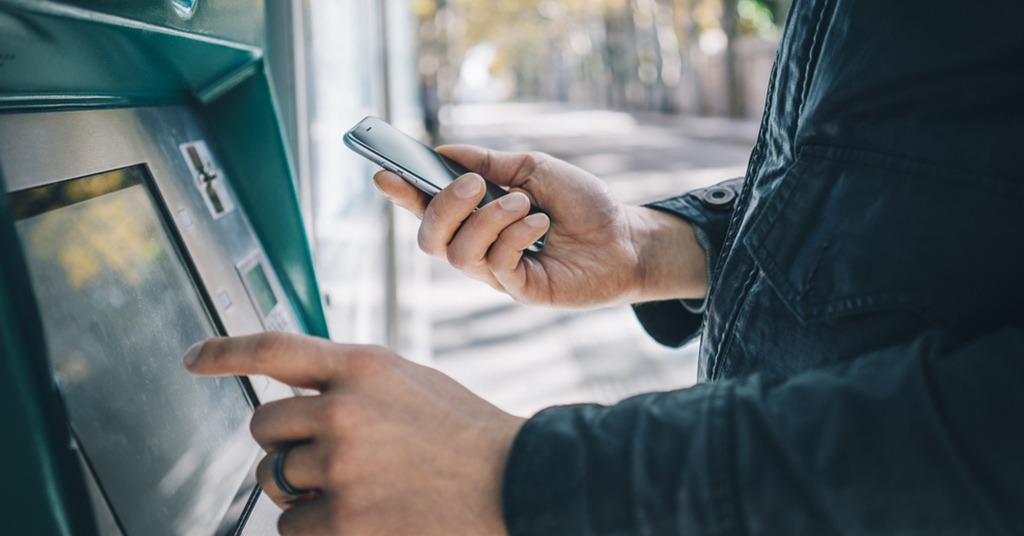Find out what are cardless ATMs and are they safe

How do cardless ATMs work: pros & cons. Source: shutterstock.com
The good thing about the 21st century is that financial inclusion is on the increase. A great many combinations of digital and physical financial solutions allow anyone to stay solvent in any circumstances. If you’re used to travelling light, the mobile wallet is probably your best friend. It is useful even in those cases when you need cash for daily transactions. After all, a growing number of cardless ATMs are installed all over the world.
What are cardless ATMs and how they work
Cardless ATMs differ from the ordinary kind by their compatibility with banking apps. Due to this synergy, a user can receive cash from the teller machine without actually inserting a debit or credit card into the relevant slot. All you need to do is to download a compatible app and add your cards to the mobile wallet storage.
The exact technology of interaction with the machine varies. Some ATMs use a scanner to read unique QR-codes, others require entering a verification code sent by SMS, while the most sophisticated ones can authenticate users by facial features or palm scan. Cardless ATMs can also be contactless where you need to hold your phone over the contactless symbol on the machine to enable the withdrawal from a chosen bank card.
Pros & Cons
According to Mastercard research, 78% of consumers would rather use a Cardless ATM solution than carry a physical card. Therefore, installing those machines is just a reasonable answer to public demand. Their main prerogative is convenience.
Cardless international ATMs like the ones powered by Mastercard eliminate the need to carry foreign currencies. People often use the services of the exchange bureaus in their home countries for many reasons. Firstly, ATMs abroad may have additional and unknown fees for cash withdrawal. Secondly, they may have unfamiliar interfaces or can be hard to locate. Hence, joining a global unified network of cardless ATMs can bring banks and financial institutions more clients, attracted by a world-famous logo plus the ability to use a familiar app.
However, separate ATMs of major local banks are also popular due to their cardless features. For instance, in the USA only, you can come across different cardless machines of at least 6 financial services providers: Bank of America, Wells Fargo, Chase, Capital One, Fifth Third Bank, and even PayPal.
Many mobile apps offer to locate the nearest ATM of the banking network which adds up to the convenience factor.
Some banks tie their accounts to the most popular mobile wallets like Google Pay, Android Pay or Samsung Pay. Hence, there’s no need to either overload your device with numerous apps or stock up your wallet with physical debit cards.
Many apps allow P2P sharing options. Someone else can pick up the cash on your behalf. In some cases, you just need to provide the app with the appropriate person’s mobile phone number. In other cases, you can simply send a QR-code or a one-time numeric code via SMS.
On the downside, the app will have to work on your current mobile device. Some banking solutions are only available for eligible Android devices. You have to look carefully at the specifications. If you don’t own a compatible phone, you may not enjoy the privilege of contactless withdrawals.
More limitations come regarding the amount allowed to withdraw, a number of transactions, the time required to enter a verification code, or availability of the cardless ATMs nearby.
While cardless ATMs are considered to be safer than using your physical card, the security of this method is still under close scrutiny.
Safety and scams

There are new, more subtle phishing scams which target these advanced ATMs. Source: shutterstock.com
Back in 2017, when the technology was only starting to develop, the New York Times scared some customers off by reporting $2,900 stolen through Chase’s new cardless system — which didn’t ask clients to enter their four-digit PIN at a cash machine at that time. Other banks which did use the PIN-protection noted that their fraud rates on mobile ATM transactions are significantly lower than those for traditional card-swipe withdrawals.
Security measures have been refined ever since. Just think about biometric recognition as an example. In Brazil, you can scan your palm which has a unique vein pattern to get cash. However, two-factor authentication is also a good measure of safety.
At the same time, those who want to steal your money, don’t idly sit on the porch. There are new, more subtle phishing scams which target these advanced ATMs. For instance, scammers may text bank customers saying their account has been locked. The message contains a link to enter your account information and “unlock your account”. If you aren’t cautious enough and click it, the scammers get your info. Remember that banks never ask for your account number, PIN code or social security number to verify your identity.
In a more sophisticated scheme, scammers who access your account can add their phone number to your account, then use their own phone to access your cash at the ATM. Hence, don’t ignore bank notifications about any unusual account activities.
SEE ALSO:








